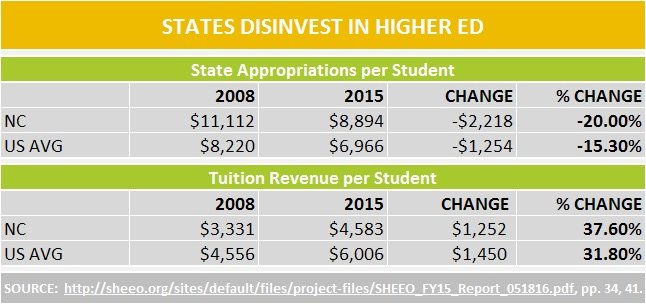RALEIGH – North Carolina’s public universities are obliged to cut $62.8 million this year. That’s what lawmakers required in the state budget signed into law this month.1
It’s not a devastating amount. Chancellors will work to limit the damage for students, researchers, and programs that directly impact regional economies.
But it’s yet another decision to disinvest from a University system that has already trimmed $700 million since 2008. And it didn’t have to happen.
Legislators entered the budget session with a hefty surplus, after all. They could have avoided the cuts and still had more than $300 million left.2 They could have used the state’s improving tax revenue to reinvest in institutions that have seen state support per student decline 20% since 2008.3
Instead, they chose to continue a trend of disinvestment from public higher education, a trend that has directly contributed to the rising cost of tuition.
Across the country, the steady erosion in state support for higher education has increased the burden on students and parents. State support as a share of educational expenses has been waning for decades, but the trend increased sharply after the Great Recession.
“Despite two years of per-student funding increases nationally, educational appropriations per student are 15.3 percent below 2008 pre-recession levels,” wrote Andrew Carlson, an analyst for the State Higher Education Executive Officers Association. He noted that only five states seized the opportunity to increase funding over the period.4
Across the country, states contributed about 61.4% of public higher education revenues in 2006. Today, that state share has slipped to 51.9%. North Carolina’s public support looks far better than the average, but it is still eroding — from 74.7% state support to 66.2%.5
Writing in praise of higher-ed cutbacks on behalf of the Pope Center for Higher Education, Jenna Ashley Robinson says such cuts help balance the budget and force universities to “eliminate wasteful and inefficient spending on campus.”6
Leaving aside that the state budget was plenty balanced without cuts to education, Robinson ignores how deeply state institutions already trimmed expenses.
From 2008-09 to 2013-14, North Carolina’s public universities produced 18% more graduates while spending 15% less cost per degree when accounting for inflation – they produced more graduates for less money.7
But eventually, less funding simply means less higher education. Less money for teachers, less money for life-changing research, less money to create ripples across regional economies, less money for the high-quality education North Carolina needs to remain competitive.
The Pope Center’s Robinson calls for exactly that: Recurring cuts, implemented year after year, regardless of budget needs or education goals.
That kind of ideological retreat from public education makes little sense at a time when North Carolina is growing, when the state’s economy is signaling a need for more well-educated workers, and public universities are reeling from almost a decade of disinvestment.
“As a state and as a nation, we must decide whether our society still values higher education—particularly public higher education,” former UNC President Tom Ross said last year. “… I am convinced – and believe the research confirms – that the value of higher education is not fully measured by one’s job title or earnings level. Higher education has value beyond the individuals who participate in it that extends to the public at large.”8
NEXT: The implications of state disinvestment for tuition, need-based financial aid and student debt.
1 http://ncleg.net/Sessions/2015/Budget/2016/Conference_Committee_Report_2016-06-27.pdf, pp. F22.
2 http://www.newsobserver.com/news/politics-government/politics-columns-blogs/under-the-dome/article89182177.html
3 http://sheeo.org/sites/default/files/project-files/SHEEO_FY15_Report_051816.pdf, page 34.
4 http://www.sheeo.org/sites/default/files/project-files/SHEF_FY15_%20PR_042716_0.pdf
5 https://public.tableau.com/profile/sheeo#!/vizhome/SHEFInteractiveStateData_1/About, Funding Distribution tab.
6 http://www.popecenter.org/2016/07/ncs-latest-higher-ed-budget-spending-less-saving/
7 http://www.higheredworks.org/2015/02/ross-the-future-of-higher-education-in-the-united-states/.
8Ibid.


Leave a Reply